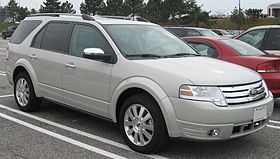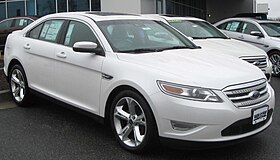Ford Taurus X
The Ford Taurus X was a 6- or 7-passenger full-size crossover SUV that was produced by Ford Motor Company in the United States. It was originally introduced in 2005 as the Ford Freestyle, before being renamed Taurus X for the 2008 model year. In Ford's lineup, it replaced the Ford Taurus station wagon. The Taurus X ended production on February 27, 2009, as it was slotted between the Flex (with which it competed directly) and the upcoming fifth generation Explorer starting 2011 sales year. It was sold in the United States and Canada, as well as South Korea and the U.S. territories of Puerto Rico, U.S. Virgin Islands, and Guam.
2005–2007
The Freestyle was previewed at the 2003 Detroit Auto Show with a Freestyle Concept before entering production for the 2005 model year. The vehicle was assembled at Chicago Assembly.
The vehicle used the Ford D3 platform, which it shared with the Ford Five Hundred, Mercury Montego, and various Volvos including the XC90. Although it shared its platform with the XC90, the two vehicles were significantly different. The Freestyle had three rows of seats with seating for seven, like many large SUVs (e.g. Ford Explorer, Ford Expedition) and minivans. The Freestyle featured what Ford describes as "command seating," seating with a higher H-point, to increase driver visibility and ease of entry and exit. Power came from a 3.0 L (181 cu in) Duratec V6, with an output of 203 hp (151 kW) at 5750 rpm.
The Freestyle, along with the Five Hundred, Mercury Montego, and the Ford Escape Hybrid, were the first American Ford vehicles to use a continuously variable transmission (CVT). The Five Hundred and Montego used a belt type CVT, while the Escape Hybrid used a CVT transaxle that utilized a planetary gearset controlled by the electric generator, similar to the Toyota Prius. All Freestyles were equipped with the CVT, but only all-wheel drive (AWD) Five Hundred and Montego models used the CVT (FWD versions used an Aisin F21++ six speed automatic). To Ford's surprise, 55% of buyers selected the Haldex Traction-equipped all-wheel drive model rather than the expected 40%. However, initial Freestyle sales were below Ford's original projections, though sales were showing steady improvement. Some buyers selected the Freestyle as an crossover alternative to the best selling truck-based Ford Explorer.
The Freestyle was nominated for the North American Truck of the Year award for 2005 (second behind Escape Hybrid).
Models:
SE: Offered only for one year (2006–2007), it included basic features such as an A/M-F/M stereo with single-disc CD/MP3 player and four speakers, keyless entry, and steel wheels with hubcaps.
SEL: Offered from 2005–2007, the SEL model had the features of the SE plus the option of leather seating, rear DVD, and an A/M-F/M stereo with a six-disc CD/MP3 changer and seven premium Audiophile speakers. It also offered optional 2nd-row captain's chairs and a standard 3rd-row bench. It also had 17" tires with alloy wheels. The option of two-tone exterior paint was offered.
Limited: Offered from 2005–2007, the Limited model had all the features of the SEL plus standard leather seating, seven speakers, and standard 2nd-row captain's chairs. It also offered monotone paint.
2008–2009
This vehicle was initially unveiled at the 2007 Chicago Auto Show as a 2008 model, alongside its siblings the Ford Taurus and Mercury Sable, re-badged, restyled versions of the Ford Five Hundred and Mercury Montego.
Ford CEO Alan Mulally said that Ford's scheme to make all its cars names start with the letter F was a bad move, as it made Ford's new cars easily forgettable. As a result of this issue being addressed, the Ford Freestyle was renamed the Taurus X, the Ford Five Hundred was renamed the Ford Taurus, and the Mercury Montego was renamed the Mercury Sable.
The Taurus X featured a grill with three horizontal, chrome bars with center mounted blue oval. At the time, the Taurus X also offered an Eddie Bauer trim-line, similar to that of the Ford Explorer. The vehicle, like its predecessor, features three rows of seats with seating for seven.
The Taurus X used the Ford D3 platform and an updated powertrain, which included the discontinuation of the CVT transmission previously used by the Freestyle, as well as the 3.0 L V6 in favor of the newly developed six-speed 6F automatic as well as the all-new 3.5 L Duratec 35 V6 which put out 263 hp (196 kW) at 6250 rpm.The vehicle also received new power options, including power-folding second-row seats and a power lift gate.
As of 2009, the Ford Flex has replaced the Freestyle as a full size CUV. The Flex also replaced the Freeestar minivan simultaneously.
Models:
SEL: The SEL was the base model Ford Taurus X offered for a year (2008–2009). It had cloth seating, optional Ford SYNC, Bluetooth, and alloy wheels.
Eddie Bauer Edition: Following the other SUV's in Ford's lineup, the EB Edition included two-tone unique leather seating, standard Ford SYNC, and standard Pueblo Gold Metallic two-tone exterior paint. It was only offered for 2008.
Limited: Serving as the top-of-the-line Ford Taurus X, the Limited offered all the features of the EB Edition plus chrome-plated alloy wheels and monotone paint. It had 18" tires and wheels.
Like the Freestyle, the Taurus X featured what Ford describes as "command seating," seating with a higher H-point, to increase driver visibility and ease of entry and exit.
Yearly American sales
| Calendar Year | Total American sales |
|---|---|
| 2004 | 8,509 |
| 2005 | 76,739 |
| 2006 | 58,602 |
| 2007 | Freestyle:23,765 Taurus X:18,345 |
| 2008 | 23,112 |
| 2009 | 6,106 |












![Validate my RSS feed [Valid RSS]](valid-rss-rogers.png)














































































